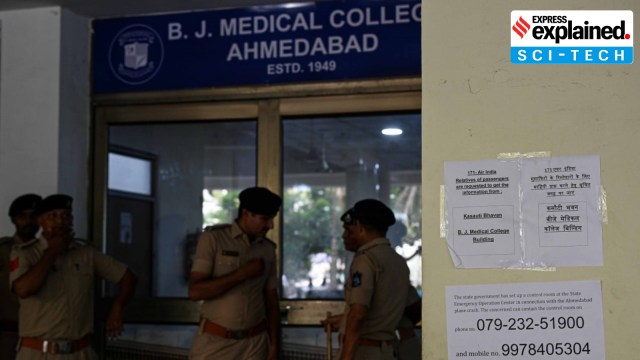Ahmedabad Air India plane crash: How DNA identification works
Air India crash victim identification: DNA identification is the gold standard for identifying human remains, especially after mass fatality events in which bodies might not be easy to identify otherwise.
 Air India crash victim identification:
Police stand guard outside the postmortem room and the Kasauti Bhavan (where the DNA samples are being taken), at BJ medical college in Ahmedabad on Saturday. (Express photo by Sankhadeep Banerjee)
Air India crash victim identification:
Police stand guard outside the postmortem room and the Kasauti Bhavan (where the DNA samples are being taken), at BJ medical college in Ahmedabad on Saturday. (Express photo by Sankhadeep Banerjee)Air India crash victim identification: After the Air India Boeing 787 Dreamliner crash in Ahmedabad, authorities are using DNA analysis to identify the remains of those killed in the accident. DNA samples from victims’ family members have already been collected, and few remains have already been identified.
With the exception of identical twins, every person has a unique DNA that is present in nearly every cell of their body. DNA identification is the gold standard for identifying human remains, especially after mass fatality events in which bodies might not be easy to identify otherwise. But how does this work?
Collecting, storing samples
As soon as an individual dies, their DNA begins to degrade. Over time, this degradation can make it difficult, even impossible, for the DNA to be analysed. The extent of degradation depends on the kind of tissue DNA is extracted from and the conditions in which the body is kept, among other factors.
- DNA survives much better in cold and dry conditions, than when it is hot and humid. This is why samples have to be collected as soon as possible, and once collected, stored in as cool and dry an environment as possible. They should ideally be frozen at minus 20 degrees Celsius, or, in the case of soft tissues (skin, muscles, etc.), they may be stored in 95% ethanol.
- DNA from soft tissues degrades much faster than that from hard tissues (bones and teeth). This is because cells in hard tissues are largely protected from the effects of putrefaction and decomposition. This is why forensic investigators usually collect DNA from hard tissue.
After plane crashes, the collection of tissue samples from the wreckage usually takes a couple of weeks. But this depends on the magnitude of the tragedy — after the September 11, 2001 attacks in New York, it took authorities 10 months to collect the samples of the nearly 3,000 victims.
To identify who the collected DNA belongs to, reference samples are collected from biological relatives. Parents and children of the victim are ideal candidates for providing these samples, given that they share 50% of each others’ DNA.
Methods of analysis
After they samples are collected, the next step is to extract DNA from them. Subsequently, depending on the quality of the collected DNA, scientists can choose between a number of different methods of analysis.
Short tandem repeat (STR) analysis: The method evaluates short tandem repeats, which are essentially short repeating sequences of DNA. STRs are used for DNA identification as they widely vary between individuals. “After analysing 15 or more of these hyper-variable regions of DNA… the resulting profile can be used to ascertain family relationships with a high degree of confidence,” according to a report by the International Committee of the Red Cross (ICRC).
Note that STRs are typically found on nuclear DNA which is located within the nucleus of a cell. Therefore, to carry out STR analysis it is essential that the nuclear DNA extracted from the sample is not degraded.
Mitochondrial DNA (mtDNA) analysis: This method is used when nuclear DNA is degraded or unavailable. Mitochondrial DNA is found within the cell’s energy-producing organelles known as mitochondria. As mtDNA is present in multiple copies within the cell, it is easier to recover from human remains that are not well preserved.
This is used for identification because mtDNA is passed down by the mother, unchanged, to all her children. This means that samples from a person’s remains can be matched with reference samples from their mother, maternal grandmother, sibling, maternal aunts or uncles, and distant relatives as long as they belong to the maternal line of inheritance.
Y chromosome analysis: Humans have two types of sex chromosomes, X and Y: biological males typically have one X and one Y chromosome, and biological females typically have two X chromosomes.
In this method, a panel of STR on Y chromosomes, passed on from father to son, is examined to match the remains of the victim with their male relatives. “This can be useful when close relatives are not available for comparison: any member of the paternal line, including brothers, paternal uncles, and paternal male cousins, may be used for matching,” the ICRC report said.
Single nucleotide polymorphisms (SNPs) analysis: The method is typically used when the DNA to be analysed is highly degraded.A SNP is a variation in the DNA sequence where a single base — A, C, G, or T — at a specific location differs among people. Given that SNPs are unique to each person, they can be used for identification purposes with the help of reference samples taken from, let’s say, the victim’s personal belongings such as a toothbrush and hairbrush.
This method is not as effective as STR analysis.






































